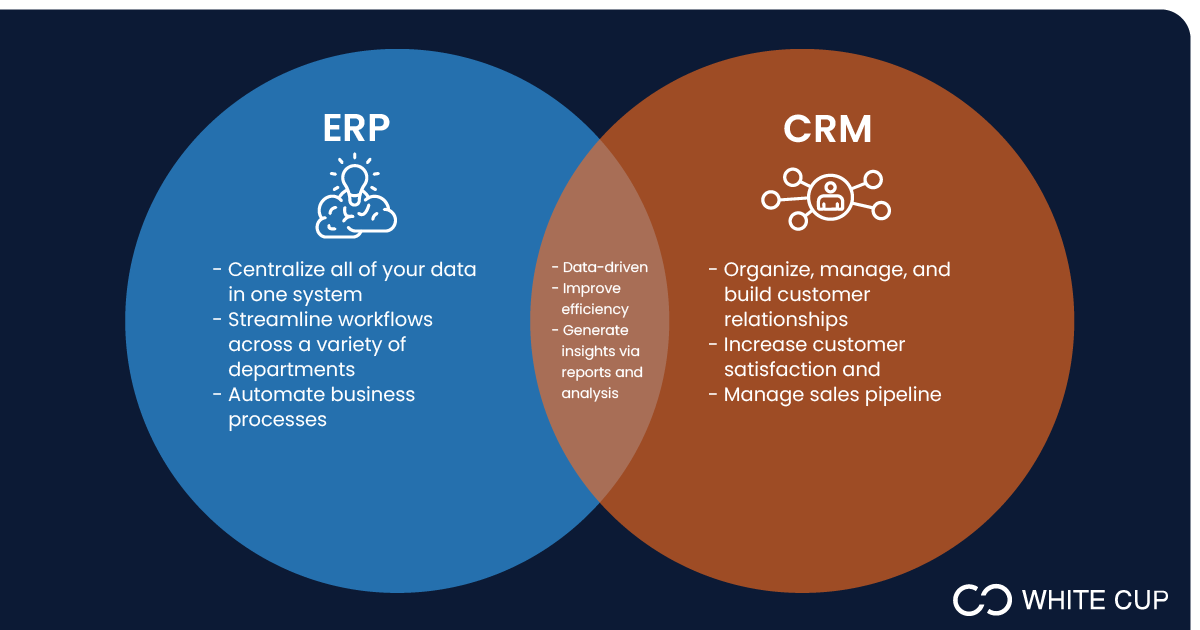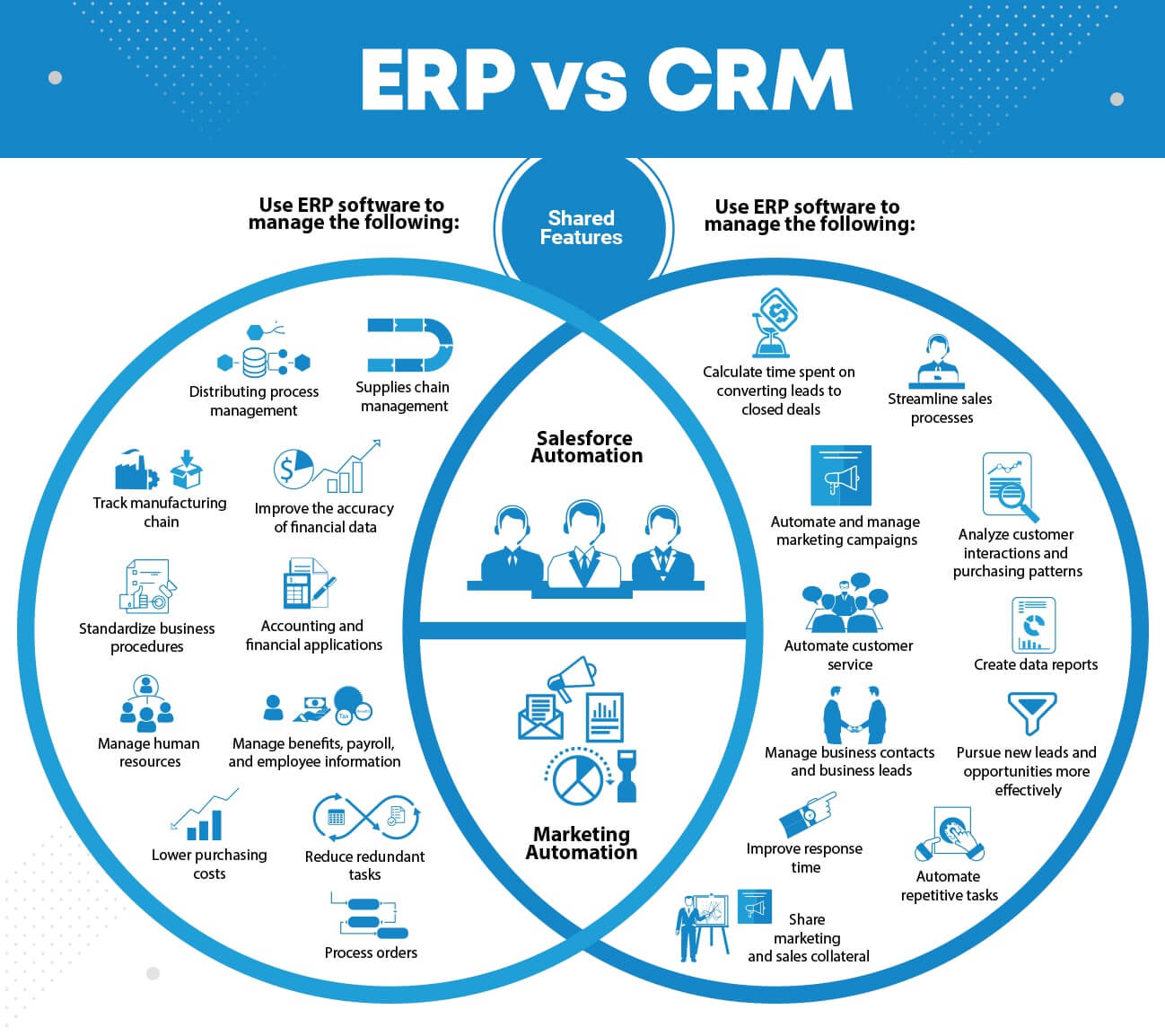CRM and ERP systems are indispensable tools for businesses seeking to streamline operations, enhance customer relationships, and gain a competitive edge. These systems offer a comprehensive suite of features and functionalities that empower organizations to manage their core processes effectively.
CRM systems, designed to manage customer interactions and relationships, provide insights into customer behavior, preferences, and buying patterns. ERP systems, on the other hand, focus on integrating and automating back-office processes such as finance, supply chain management, and human resources.
CRM and ERP System Overview

Customer relationship management (CRM) and enterprise resource planning (ERP) systems are two of the most important software applications for businesses of all sizes. CRM systems help businesses manage their interactions with customers, while ERP systems help businesses manage their internal operations.
Both CRM and ERP systems can provide businesses with a number of benefits, including improved efficiency, increased productivity, and better decision-making.
Key Features and Benefits of CRM Systems
CRM systems typically include features such as contact management, lead tracking, opportunity management, and customer service. These features can help businesses track their interactions with customers, identify and qualify leads, and close deals. CRM systems can also help businesses provide better customer service by giving them a centralized view of all customer interactions.
- Improved customer service
- Increased sales
- Better marketing
- Improved efficiency
Key Features and Benefits of ERP Systems
ERP systems typically include features such as financial management, human resources management, supply chain management, and manufacturing management. These features can help businesses manage their finances, track their inventory, and plan their production. ERP systems can also help businesses improve their supply chain management by giving them a real-time view of their inventory levels and orders.
- Improved financial management
- Increased productivity
- Better decision-making
- Improved supply chain management
Differences and Similarities Between CRM and ERP Systems
CRM and ERP systems are both important software applications for businesses, but they serve different purposes. CRM systems focus on managing customer interactions, while ERP systems focus on managing internal operations. However, there are some similarities between the two systems.
Both CRM and ERP systems can help businesses improve their efficiency, increase their productivity, and make better decisions.
- Differences
- CRM systems focus on managing customer interactions, while ERP systems focus on managing internal operations.
- CRM systems typically include features such as contact management, lead tracking, opportunity management, and customer service, while ERP systems typically include features such as financial management, human resources management, supply chain management, and manufacturing management.
- Similarities
- Both CRM and ERP systems can help businesses improve their efficiency, increase their productivity, and make better decisions.
- Both CRM and ERP systems can be integrated with other software applications, such as accounting software and email marketing software.
ERP System Analysis

ERP (Enterprise Resource Planning) systems are comprehensive software solutions designed to integrate and streamline various business processes across an organization. Conducting a thorough analysis of an ERP system involves evaluating its functionalities, understanding its core modules and processes, and assessing its advantages and limitations.
Core Modules and Processes
ERP systems typically consist of several core modules that cover key business areas such as finance, supply chain management, human resources, and customer relationship management. These modules are integrated and interact with each other to provide a holistic view of the organization’s operations.
- Financial Management:Manages financial transactions, accounting, budgeting, and reporting.
- Supply Chain Management:Oversees inventory management, procurement, order fulfillment, and logistics.
- Human Resources:Handles employee information, payroll, benefits, and performance management.
- Customer Relationship Management:Tracks customer interactions, sales, and support activities.
Advantages of ERP Systems, Crm and erp system
ERP systems offer numerous advantages to businesses, including:
- Improved Efficiency:Automates and streamlines processes, reducing manual labor and errors.
- Enhanced Data Visibility:Provides a centralized repository of data, improving transparency and decision-making.
- Increased Collaboration:Facilitates communication and collaboration among different departments.
- Better Customer Service:Integrates customer-related data, enabling businesses to respond to inquiries and resolve issues more effectively.
Limitations of ERP Systems
Despite their benefits, ERP systems also have certain limitations:
- High Implementation Costs:ERP systems can be expensive to purchase, implement, and maintain.
- Complexity:ERP systems are complex and require significant training and expertise to operate effectively.
- Customization Challenges:ERP systems may not be easily adaptable to specific business requirements.
- Vendor Dependence:Businesses may become dependent on the vendor for ongoing support and upgrades.
Case Studies and Examples

Numerous organizations have successfully implemented CRM and ERP systems, reaping significant benefits. These case studies provide valuable insights into the challenges, strategies, and outcomes of such implementations.
One notable example is the integration of Salesforce CRM with SAP ERP at Nike. This integration streamlined sales processes, improved customer data management, and enhanced operational efficiency. As a result, Nike experienced increased sales conversions, improved customer satisfaction, and reduced operational costs.
Lessons Learned and Best Practices
Case studies highlight several lessons learned and best practices for successful CRM and ERP implementations:
- Define clear objectives and align them with business goals.
- Involve stakeholders throughout the implementation process.
- Ensure data accuracy and consistency across systems.
- Adopt a phased approach to minimize disruption.
- Provide ongoing training and support to users.
- Monitor and evaluate system performance regularly.
- Foster a culture of data-driven decision-making.
End of Discussion

In conclusion, CRM and ERP systems are essential investments for businesses looking to optimize their operations, improve customer satisfaction, and drive growth. By integrating these systems, organizations can gain a holistic view of their business, make informed decisions, and stay ahead in today’s competitive market.
FAQ Overview
What are the key differences between CRM and ERP systems?
CRM systems focus on managing customer interactions and relationships, while ERP systems integrate and automate back-office processes.
What are the benefits of integrating CRM and ERP systems?
Integrating CRM and ERP systems provides a holistic view of the business, improves customer satisfaction, and drives growth.
What are some emerging trends in CRM and ERP systems?
Artificial intelligence (AI) and cloud computing are driving innovation in CRM and ERP systems, enabling businesses to automate processes, gain insights, and improve decision-making.